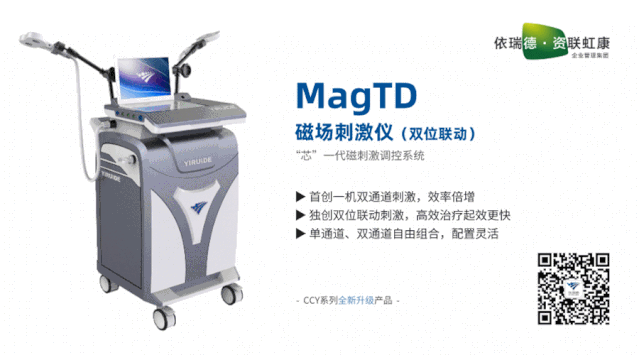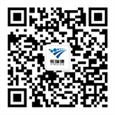
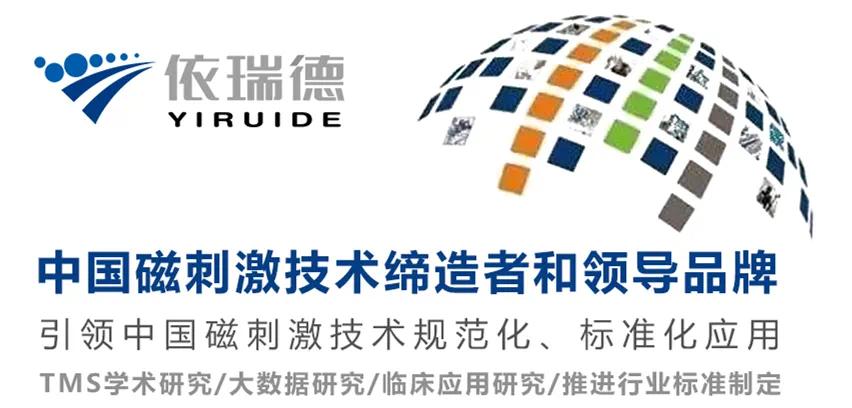
经颅磁刺激技术(TMS)作为一种新型物理诊疗技术,其安全性和有效性受到广泛关注。TMS常见的不良反应有轻微头痛、头皮刺痛、磁刺激时的噪声,这些均与刺激参数有关,通过技术改进和参数调整均可降低损害。
除此之外,TMS最严重的不良反应是诱发癫痫,但发生率比较低,且TMS诱发的癫痫发作是自限的、暂时的,并无远期影响[2][3][4]。
从不良反应上来看,TMS有比较高的安全性,但经常有操作师提出这样的疑问:目前大部分科研或临床案例都集中在18-60周岁人群,对于婴幼儿或者高龄老年人等这类特殊群体,经颅磁刺激还是否安全?
今天,我们来根据现有的证据,详细了解一下“TMS适用年龄范围”。


TMS用于儿童
由于儿童中枢神经系统发育尚不完善,在治疗的过程中需要格外注意以下几个问题:
一是囟门闭合情况,在治疗过程中需考虑磁刺激线圈对囟门可能造成的物理或者神经损伤;
二是外耳道发育情况,婴幼儿的外耳道正处于发育期,为防止TMS产生的噪音损伤,建议使用耳塞进行防护;
三是充分考虑诱发癫痫发作的风险,由于新生儿的大脑皮层兴奋性较高(1岁之前达到峰值),具有更高的癫痫发作风险。
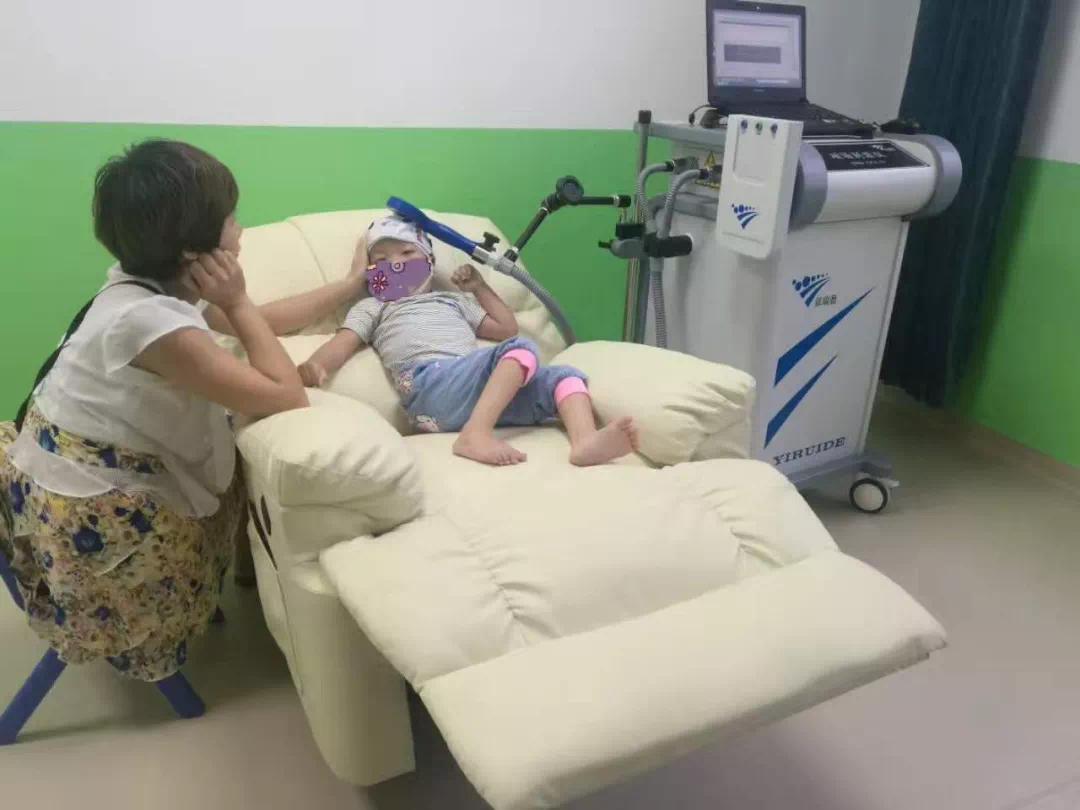
▲依瑞德TMS用于婴幼儿治疗
2009版《TMS安全指南》[5]纳入分析80多项研究应用800多名正常儿童和300多名患儿情况,发现绝大多数研究都应用了单脉冲和成对脉冲进行神经检测,少量的研究用于治疗,并对2岁以下婴幼儿的应用做出了建议:

随着TMS应用的增多,研究数据不断增加,以下增加分析了一些3岁及以下婴幼儿的研究应用,详情如下:
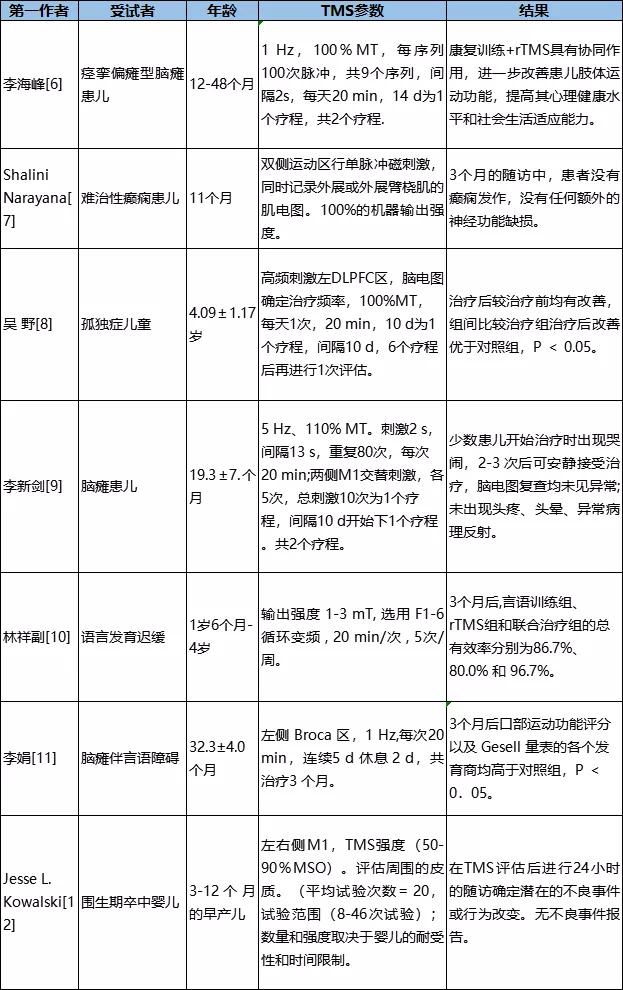
从以上研究可以发现,在TMS检测领域,最小使用年纪是3-12个月大的围生期卒中早产儿[12]。也有研究提到,单脉冲和双脉冲TMS被认为是非常安全的,早在新生儿期就被用于健康儿童和有中枢神经病变的儿童,如围产期中风[13,14]。
另有一项针对18个年龄在2个月-16岁之间的儿童利用TMS检测研究时,没有听力保护,但未发现听力功能异常[15]。
在TMS治疗领域,最小的受益者是一位只有11个月大的具有难治性癫痫患儿[7]。有研究表明TMS对具有神经系统疾病的儿童是安全的,包括癫痫的儿童[16]。
值得注意的是,儿童的运动阈值通常高于成人水平,导致TMS设备输出强度更大,容易超过儿童大脑承受能力而产生过度激活。所以建议根据小儿不同发育阶段的皮层兴奋性,进行大样本的研究,以确定小儿群体中安全有效的刺激强度和频率。

TMS用于老年人
随着年龄增长,老年人的生理功能也发生了变化,更容易受到精神药物副作用的影响,会限制剂量滴定和药物的有效性。而TMS刺激是局灶性的,非全身性的,因此更具优势。
以下是部分老年患者的研究,可以看出老年患者使用TMS也是比较安全的:


总结
有研究表明,单脉冲或成对脉冲对脑组织的伤害可能性极小[34]。与MRI的磁场相比,TMS更加针对大脑的局灶性位置,磁场体积很小,并随距离呈指数下降。因此,位于线圈上方稍远距离的组织不会受到影响[35]。
2014年Cochrane的一项回顾[36]发现,真rTMS的不良事件并不比假rTMS更常见,医学上使用rTMS的唯一绝对禁忌症是在刺激部位附近有植入物或铁磁性装置。
总之,已有研究证实,在严格把握适应症和禁忌症的前提下,TMS可以安全应用于上至七十多岁的老年患者,下至几个月的婴幼儿。
当然,更肯定的回答还需进一步的研究来支持。
[1] Zhao J, Yi ZH, Wang JJ. Research advance of repetitive transcranial magnetic stimulation in the treatment of cognitive function disorder [J]. J Psychiatry, 2011, 24(2): 145-147.
[2] Rossi S, Hallett M, Rossini PM, et al. Safety, ethical considerations and application guidelines for the use of transcranial magnetic stimulation in clinical practice and research [J]. Clin Neurophysiol, 2009, 120(12): 2008-2039.
[3] Rosa MA, Odebrecht M, Rigonatti SP, et al. Transcranial magnetic stimulation: review of accidental seizures [J]. Rev Bras Psiquiatr, 2004, 26(2): 131-134.
[4] Rachid F, Bertschy G. Safety and efficacy of repetitive transcranial magnetic stimulation in the treatment of depression: a critical appraisal of the last 10 years [J]. Neurophysiol Clin, 2006, 36(3): 157-183.
[5] Simone Rossi, Mark Hallett et al.Safety, ethical considerations, and application guidelines for the use of transcranial magnetic stimulation in clinical practice and research[J].Clinical Neurophysiology,2009.
[6] 李海峰, 尹宏伟, 邹艳,等. 重复经颅磁刺激对痉挛偏瘫型脑瘫患儿肢体运动功能的影响[J]. 中华物理医学与康复杂志, 2016, 038(006):433-435
[7] Narayana Shalini,Mudigoudar Basanagoud,Babajani-Feremi Abbas,Choudhri Asim F,Boop Frederick A. Successful motor mapping with transcranial magnetic stimulation in an infant: A case report.[J]. Neurology,2017,89(20).
[8] 吴野, 李新剑, 金鑫, et al. 高频经颅磁刺激背外侧前额叶联合康复训练对孤独症谱系障碍儿童的治疗作用[J]. 中国医药导报, 2016, 13(27).
[9] 李新剑, 宋伟, 仇爱珍, et al. 经颅磁刺激术联合康复训练对脑性瘫痪患儿日常精细动作及认知功能发育的影响[J]. 中国全科医学, 2016(18期):2184-2187.
[10] 林祥副, 谭育华, 吴仲环,等. 重复经颅磁刺激联合言语训练治疗儿童语言发育迟缓的临床研究[J]. 中国实用医药, 2016(7):8-10,共3页.
[11] 李娟,尚清.低频重复经颅磁刺激结合言语训练对小儿脑瘫言语障碍的影响[J].生物医学工程学进展,2018,39(04):238-240.
[12] Kowalski Jesse L,Nemanich Samuel T,Nawshin Tanjila et al. Motor Evoked Potentials as Potential Biomarkers of Early Atypical Corticospinal Tract Development in Infants with Perinatal Stroke.[J] .J Clin Med, 2019, 8: undefined.
[13] Eyre JA, Taylor JP, Villagra F, Smith M, Miller S. Evi-dence of activity-dependent withdrawal of corticospinal projections during human development.Neurology. 2001;57:1543–54.
[14] Eyre JA, Smith M, Dabydeen L, Clowry GJ, Petacchi E,Battini R, et al. Is hemiplegic cerebral palsy equivalent to amblyopia of the corticospinal system? Ann Neurol.2007;62:493–503.
[15] Collado-Corona M.A., Mora-Magana I., Cordero G.L., et al., Transcranial magnetic stimulation and acoustic trauma or hearing loss in children, Neurol. Res., 2001, 23, 343-346
[16] Allen CH, Kluger BM, Buard I. Safety of transcranial magnetic stimulation in children: a systematic review of the literature. Pediatr Neurol. 2017;68:3–17.
[17] Ferreri F , Vecchio F , Vollero L , et al. Sensorimotor cortex excitability and connectivity in Alzheimer\"s disease: A TMS-EEG Co-registration study[J]. Human Brain Mapping, 2016, 37(6):2083-2096.
[18] Nguyen J P , Suarez A , Kemoun G , et al. Repetitive transcranial magnetic stimulation combined with cognitive training for the treatment of Alzheimer\"s disease[J]. Neurophysiologie Clinique/clinical Neurophysiology, 2017, 47(1):47-53.
[19] Nilakantan A S , Mesulam M M , Weintraub S , et al. Network-targeted stimulation engages neurobehavioral hallmarks of age-related memory decline[J]. Neurology, 2019.
[20] 党宝齐,陈文莉,高凡,俞晓.高频重复经颅磁刺激治疗老年卒中后抑郁的临床疗效[J].实用老年医学,2019,33(05):469-471.
[21] 于丽燕,谢姗姗.重复低频经颅磁刺激联合阿戈美拉汀治疗老年抑郁症的临床疗效[J].实用老年医学,2019,33(08):797-800.
[22] Fabre I, Galinowski A, Oppenheim C, et al. Antidepressant
efficacy and cognitive effects of repetitive transcranial mag-
netic stimulation in vascular depression :an open trial [ . Int J
Geriatr Psychiatry, 2004, 19 (9) :833-842.
[23] Abraham et al. Neuropsychiatr Dis Treat,2007,3日919~924.
[24] Milev et al.JECT ,2009,25 0) :44~49.
[25] Hilzi et al. Neuropsychiatr DisTreat,2013,9 501~504
[26] 胡蕊,等.中国老年学志,2014,34 (10 :5378~5380.
[27] 伍卫,等.中国老年保健学,2015,13(2):71~73.
[28] 李艳艳,等.国际精神病学杂志,2017,44(1) :12~15.
[29] 顾培,等.中国临床心理学杂志,2017,25①) 588~590.
[30] Livia D M H , Luiz M M , Maia Memória Cláudia, et al. Transcranial Magnetic Stimulation to Address Mild Cognitive Impairment in the Elderly: A Randomized Controlled Study[J]. [24]Behavioural Neurology, 2015, 2015:1-13.
[31] Houde F , Laroche S , Thivierge V , et al. Transcranial Magnetic Stimulation Measures in the Elderly: Reliability, Smallest Detectable Change and the Potential Influence of Lifestyle Habits[J]. Frontiers in Aging Neuroscience, 2018, 10.
[32] Shahid B , Perez J M , Horvath J C , et al. Differential effects of motor cortical excitability and plasticity in young and old individuals: a Transcranial Magnetic Stimulation (TMS) study[J]. Frontiers in Aging Neuroscience, 2014, 6.
[33] Jin-Woo, Park, Hyojun,et al. A pilot study of the effects of high-frequency repetitive transcranial magnetic stimulation on dysphagia in the elderly.[J]. Neurogastroenterology & Motility the Official Journal of the European Gastrointestinal Motility Society, 2019.
[34] Gilbert D.L., Garvey M.A., Bansal A.S., Lipps T., Zhang J., Wassermann E.M., Should transcranial magnetic stimulation research in children be considered minimal risk?, Clin. Neurophysiol. 2004, 115,1730-1739
[35] Rajapakse T , Kirton A . Non-invasive brain stimulation in children: Applications and future directions[J]. Translational Neuroscience, 2013, 4(2):217-233.
[36] O’Connell NE, et al. Non-invasive brain stimulation techniques for chronic pain. Cochrane Database Syst Rev. 2014;(4):Cd008208.
▲上下滑动查看

TMS技术交流群
▼


